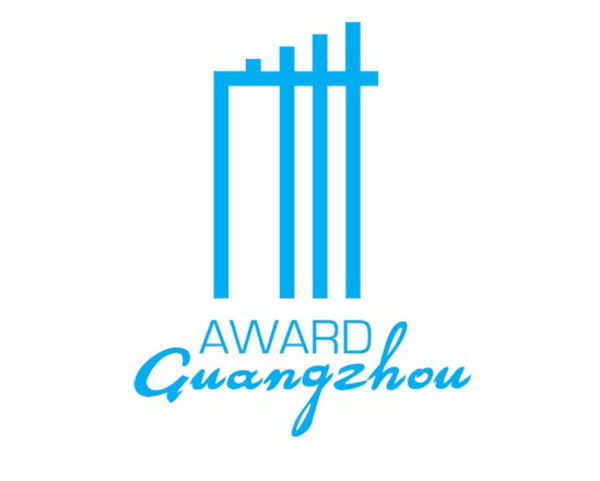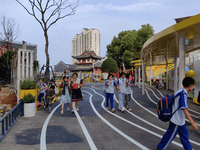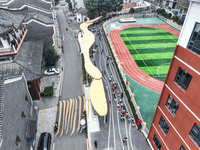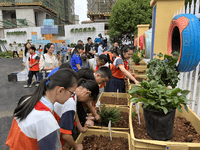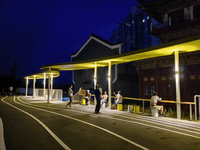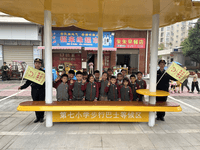This initiative seeks to significantly improve traffic safety around schools and optimize student-safe commuting routes, elevating these concerns to the municipal government level. By doing so, we aim to create city-wide positive change. Implementation of this project required a robust multi-departmental collaboration, actively drawing participation from various entities including the Mayor's Office, Housing and Urban-Rural Development Bureau, Urban Planning Department, City Management Committee, Traffic Police, Neighborhood Committees, Education Bureau, schools, and private developers. Within our design approach, we introduced the concept of co-creation, earnestly incorporating student ideas and feedback to ensure their needs and perspectives drive the solutions. This comprehensive approach considers both traffic safety enhancements and upgrades to lighting infrastructure, fostering a safe and appealing route for students to walk to school. Ultimately, this strategy aims to diminish the necessity for parents to drive their kids, promoting walking instead. A significant achievement is the formulation and broad dissemination of a set of guidelines to numerous schools and cities.
Guangzhou Award
This project was awarded the 'Guangzhou Award' in 2023.This project was awarded the 'Guangzhou Award' in 2023 in the following category: The City of Your Choice.
In China, where the one-child policy has had many impacts, every child's safety and well-being is paramount to families and the nation's future. Surprisingly, their daily journeys to school, even in advanced cities, are riddled with risks, often overlooked by national, provincial and city policymakers. Traffic congestion and safety concerns near schools pose significant urban management challenges. Addressing this demands collaboration across multiple departments, such as education, transportation, policing, and more, coupled with enhanced awareness among parents. The solutions tend to be piecemeal, often hindered by coordination challenges. Many parents, apprehensive about their children's safety, choose to drive them to school, exacerbating not only traffic issues and a lot of time is wasted. However, with financial constraints and no national directive, particularly in smaller cities, prioritizing and executing effective solutions remains an uphill task.
The initiative is anchored in the UN's 1996 "Child-Friendly Cities" concept and China's 2021 directives: the "China Children's Development Program (2021-2030)" and the "Guiding Opinions on Promoting the Construction of Child-Friendly Cities."
The initiative seeks to significantly improve traffic safety around schools and optimize student-safe commuting routes.
Traffic congestion around city schools poses a significant challenge to urban management. A primary contributor to this problem is parents driving to drop off or pick up their children. This often leads to congestion at school entrances due to limited space, jeopardizing child safety. Furthermore, disparities in educational resources across different parts of the city, largely stemming from economic variations, exacerbate the issue.
Our action plan emphasizes the importance of creating high-quality public spaces for urban residents. By transforming disadvantaged school environments into child-friendly, learning-oriented spaces, we can address educational inequality in cities. Such environments not only encourage marginalized children to engage in social interactions, strengthening their communication skills and problem-solving abilities, but they also offer a fun, creative outlet. This is crucial for preventing negative psychological outcomes in these children. Rebuilding excellent child-friendly and learning-oriented environments in poorer social surroundings can alleviate the problem of educational inequity in cities. It also encourages left-behind children (both parents working in another city) to promote social interaction, strengthen their communications and social connections, enjoy the fun of creativity, and work collaboratively to solve problems — all of which can help prevent adverse psychological outcomes in children.
The proposed public spaces are designed with children's inputs and prioritize learning. Notably, over 50% of the materials used derived from recycled waste products. Our goal is to promote learning through play in these areas, aiming for healthier physical and psychological interactions among children. A successful children's public space can bolster learning, enhance parent and neighbour interactions, foster a sense of community, and instil local pride.
However, there's a noticeable gap in standard norms and design guidelines for such projects. Successful implementation requires collaboration across multiple departments for a holistic transformation.
Our initiative fostered a holistic collaboration between municipal leaders, various departments, and private entities to enhance the urban school environment:
Municipal Leadership: Leaders engaged with schools in person, interacted directly with schools, understanding concerns about traffic and promoting low-carbon commuting and eco-friendly lifestyles. Sought collaboration with all relevant departments to help create safer and child-friendly streets. Municipal leaders further enabled students to act as "Junior Mayors" for half a day, fostering their awareness of and participation in politics and policymaking.
City Planning Department: The department redirected funds for new teaching structures and transformation of toilet facilities. It coordinated with neighbouring unused land to create a bike parking space and allow the ground floor apartments to change land use to shops and food stalls to animate street life and to provide healthy and affordable meals to school children and teachers. It introduced breakfast and education-related businesses to the school vicinity by issuing new zoning permits. It organized the development of city-level child-friendly planning and design guidelines for schools and their surrounding environment, a first in China.
Housing and Construction Bureau: The bureau reallocated funds to establish uninterrupted pedestrian paths outside schools, with an emphasis on eradicating sidewalk parking to bolster traffic safety.
City Management Committee: This committee implemented new traffic signal control systems at intersections frequently used during school commute hours, installed security surveillance cameras, and added new streetlights along the roads.
Private Developers: They granted access to their roads, removed walls and fences, and provisioned open spaces for makeshift parking, minimizing clashes between pedestrians and vehicles during school hours.
Guangzhou Water Group: Contributing uniquely, this group donated planting soil, a by-product of their innovative wastewater treatment process (patented technology). They also championed student education on environmental consciousness, sustainable practices, low-carbon initiatives, and waste recycling applications within the renovation project.
The initiative had a combined budget of 650,000 USD, with the city's Xianning Urban Management Committee contributing 430,000 USD and the Xianning Housing and Urban-Rural Development Bureau adding 220,000 USD. This funding accelerated infrastructure enhancements around the school, such as main road and sidewalk renovations, undergrounding of hazardous overhead cables, and improvements to pedestrian and bike lanes.
Additionally, the initiative saw the elimination of sidewalk parking and the inception of a school bus service. In a commendable private-public collaboration, Xiangcheng Ancient Street developers voluntarily dismantled barriers, allowing pedestrian access, and offered vacant space for temporary school parking. Moreover, local factories supplied waste materials such as bottles, metal, and tires. The Guangzhou water bureau donated recycled soil derived from water plant sludge. Talented local artists transformed these waste materials into imaginative street furniture and public space decorations.
The assessment of the initiative's impact is spearheaded by the project implementation department and the design team. They are evaluating the project's effectiveness by contrasting satisfaction levels pre and post-implementation among students, parents, and local residents, as well as examining the shifts in traffic operation indicators. This data collection is nuanced, with disaggregation by gender, age, and income brackets to ensure an understanding of the project's impact across different demographic groups. Before/after photos are also being done.
The project directly impacts 800 school students and extends its benefits to their parents, families, and neighbouring residents. With the project serving as a model, Xianning City has initiated similar enhancements for five schools and a kindergarten. This expansion will positively affect over 3,000 children and teenagers, around 6,000 parents, and an estimated 30,000 residents within these 6 communities, fostering safer and more child-friendly environments.
To ensure the sustainability of the innovation, the Xianning City government is drafting guidelines for child-friendly urban development. The goal is to extend the initiative across the city, encompassing kindergartens, elementary schools, and middle schools. These steps aim to integrate educational components into urban areas, enhancing the city's appeal to younger generations. Additionally, the Hubei Provincial Department of Housing and Urban-Rural Development is issuing guidelines to transform school surroundings, further promoting child-friendly environments.
The challenges and difficulties faced by this initiative include the following five points:
- Linking the United Nations SDG goals with China's urban planning and development as well as existing projects involves incorporating international advanced concepts into urban needs and projects. This process aims to create high-quality project proposals that align with local requirements and to persuade municipal leaders and decision-makers to embrace this innovation.
- The challenges arise from the necessity of increasing additional project budgets as innovation requires additional expenses. Under the backdrop of financial constraints, urban renewal projects initiated after the COVID-19 pandemic typically receive government funding with a primary focus on meeting functional requirements, subject to rigorous financial investment scrutiny. However, this initiative has gained government support and implemented measures such as adjusting departmental budgets and subdividing project components.
- The advancement and implementation of this project took place during the COVID-19 pandemic, and the collaborative activities with schools were also conducted under immense pressure.
- The non-traditional and unique structures created by students are transformed into physical objects using methods such as 3D printing and handcrafting with fiberglass. Additionally, the durability and compliance with engineering acceptance standards are ensured for these creations.
- The extensive use of recycled materials in the project poses challenges during engineering acceptance and auditing processes. To address this issue, this initiative collaborates with the urban planning bureau to develop city-level design guidelines, providing clarity and promotion for the incorporation of recycled materials.
The initiative extends to cities in multiple provinces and cities in China, with plans underway for five cities in Hubei and Nansha in Guangzhou (Guangdong). Additionally, the project has gained recognition and promotion through international organisations including UN Habitat and the UN Children’s Fund.
External links / documents
Want to know more about this project?
